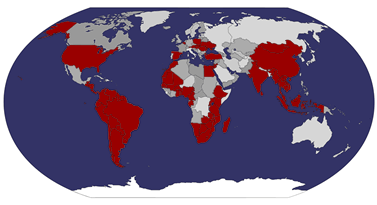But I get ahead of myself.
Let´s go way back in time to Suriname, land of the Jews.
"What?" you say. "I didn´t know there were Jews in Suriname..."
Well, join the club. But it turns out that Suriname, a Dutch colony until the embarrassingly late decade of the 1970s and now a small nation on the northern coast of South America (sandwiched between Guyana and French Guyane) once had one-quarter of its population made up of Jews (though we figured out that this was not including slaves, which it seems dwarfed the entire colonial population considerably).
A large synagogue still stands in central Paramaribo (the capital). Apparently it is still used for services on Shabbat, though our timing was not right to check that out or get a tour inside, which has to be arranged a day in advance.

The synagogue dates from the 1800s. It stood right next to this admittedly rather more impressive mosque...

But since the getting along nicely of various cultures seems to be the national theme of Suriname (where the population is a very heterogenous mix of African, Indonesian, Chinese, Amerindian, and Dutch people, with many tasty cuisines to boot!), the proximity did not seem to cause trouble.
Anyway, my people (OK, I use that term very loosely, since 1) I´m not religious and 2) the Jews in Suriname were Sephardic Portuguese immigrants, which is about as far as you can get from my Ashkenazi Eastern European heritage) did not just stick to the city when they came over in the 1600s, but actually had their own giant plantation south of Paramaribo along the Suriname river. This was called the Jodensavanne (Jew´s Savannah), and the remains of it are now a national historic site.
The site itself is beautiful and tranquil, with forest having reclaimed much of the land that was once under cultivation. We visited the Africans´ cemetary (yes, these Jews owned slaves--but apparently made a lot of enemies among other plantation owners for giving their slaves the Sabbath off) and the Jews´ cemetary. But the main site to visit is the foundations of the synagogue, which counts as the oldest surviving synagogue in the Western hemisphere.

This being Suriname, nothing was roped off, and you could go climb all over the monument.
The best thing we learned about the synagogue was that, during World War 2, a German spy ship was captured in Suriname and the crew imprisoned. As their punishment, they were put to work restoring the synagogue at Jodensavanne, which had fallen into disrepair after the plantation was abandoned (I think in the late 1800s or early 1900s). So, yes, the synagogue was actually restored by forced Nazi labor!
Our last stop at Jodensavanne was the "medicinal well" which still produces a trickle of water.

Back in the day, doctors apparently documented the abilities of water from this well to cure all sorts of ailments, including constipation. I am still waiting for this to work.


No comments:
Post a Comment